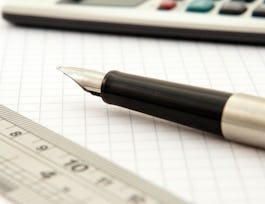This course is intended for students looking to create a solid algebraic foundation of fundamental mathematical concepts from which to take more advanced courses that use concepts from precalculus, calculus, probability, and statistics. This course will help solidify your computational methods, review algebraic formulas and properties, and apply these concepts model real world situations. This course is for any student who will use algebraic skills in future mathematics courses. Topics include: the real numbers, equalities, inequalities, polynomials, rational expressions and equations, graphs, relations and functions, radicals and exponents, and quadratic equations.


Algebra: Elementary to Advanced - Equations & Inequalities
This course is part of Algebra: Elementary to Advanced Specialization
Taught in English
Some content may not be translated

Instructor: Joseph W. Cutrone, PhD
Top Instructor
33,190 already enrolled
Included with 
Course
(456 reviews)
96%
Details to know

Add to your LinkedIn profile
9 quizzes
Course
(456 reviews)
96%
See how employees at top companies are mastering in-demand skills

Build your subject-matter expertise
- Learn new concepts from industry experts
- Gain a foundational understanding of a subject or tool
- Develop job-relevant skills with hands-on projects
- Earn a shareable career certificate


Earn a career certificate
Add this credential to your LinkedIn profile, resume, or CV
Share it on social media and in your performance review

There are 5 modules in this course
Georg Cantor was a famous mathematician who formalized the notion of set theory, which had a profound impact on research and teaching. Sets and the relations between them for a basis for teaching the concept of the structure of Real numbers. Starting with the concept of a natural number, {1,2,3,...} the whole numbers, integers, rationals, and real numbers are developed, as well as operations defined on them. Properties of the real numbers are formalized and applied as well.
What's included
2 videos5 readings2 quizzes
A linear relationship between two variables occurs when there is a constant increase or constant decrease in one variable with respect to the other. Linear equations have the property that any change in the independent variable results in a proportional change in the dependent variable. Many physical situations can be modelled using a linear relationship. When data is visualized on a scatterplot, we often are interested in the line of best fit or the regression line. Linear equations occur frequently in all mathematics and their applications in physics and engineering, partly because non-linear systems are often well approximated by linear equations.
What's included
3 videos5 readings2 quizzes
The relative position of two points on a coordinate line is used to define an inequality relationship on the set of real numbers. We say that a is less than b, written a<b, when the real number a lies to the left of the real number b on the coordinate line. From this definition, other inequalities naturally follow.
What's included
2 videos4 readings2 quizzes
Recall that a single linear equation in two variables is an equation of the form Ax + By = C, where A and B are both nonzero real constants. There are infinitely may ordered pairs that satisfy a single linear equation. In applications however, we are often interested in finding a single ordered pair that satisfies a pair of linear equations. In this section, we discuss several methods for solving this problem.
What's included
2 videos4 readings2 quizzes
Congratulations on reaching the final exam! This final assessment will be cumulative in nature, covering all aspects of the course. Use this final as a teaching tool: justify what you know and identify areas for improvement. Use scrap paper as you take this final. Try to use any formula sheets or outside resources as a tool and not a crutch. Check your answers before you submit. After the test, review any incorrect answers to find your mistakes. Try to separate "silly" mistakes from the more substantial mistakes in understanding. Good luck!
What's included
1 quiz
Instructor

Offered by
Recommended if you're interested in Math and Logic

Johns Hopkins University

Johns Hopkins University

Johns Hopkins University

University of North Texas
Why people choose Coursera for their career




Learner reviews
Showing 3 of 456
456 reviews
- 5 stars
85.15%
- 4 stars
11.13%
- 3 stars
1.96%
- 2 stars
0.65%
- 1 star
1.09%

Open new doors with Coursera Plus
Unlimited access to 7,000+ world-class courses, hands-on projects, and job-ready certificate programs - all included in your subscription
Advance your career with an online degree
Earn a degree from world-class universities - 100% online
Join over 3,400 global companies that choose Coursera for Business
Upskill your employees to excel in the digital economy
Frequently asked questions
Access to lectures and assignments depends on your type of enrollment. If you take a course in audit mode, you will be able to see most course materials for free. To access graded assignments and to earn a Certificate, you will need to purchase the Certificate experience, during or after your audit. If you don't see the audit option:
The course may not offer an audit option. You can try a Free Trial instead, or apply for Financial Aid.
The course may offer 'Full Course, No Certificate' instead. This option lets you see all course materials, submit required assessments, and get a final grade. This also means that you will not be able to purchase a Certificate experience.
When you enroll in the course, you get access to all of the courses in the Specialization, and you earn a certificate when you complete the work. Your electronic Certificate will be added to your Accomplishments page - from there, you can print your Certificate or add it to your LinkedIn profile. If you only want to read and view the course content, you can audit the course for free.
If you subscribed, you get a 7-day free trial during which you can cancel at no penalty. After that, we don’t give refunds, but you can cancel your subscription at any time. See our full refund policy.

